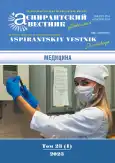Биометрические параметры верхней зубной дуги у пациентов со стабильным результатом ортодонтического лечения аномалий положения коронок клыков верхней челюсти
- Авторы: Русанова Д.А.1
-
Учреждения:
- ФГБОУ ВО «Пермский государственный медицинский университет имени академика Е.А. Вагнера» Минздрава России
- Выпуск: Том 23, № 1 (2023)
- Страницы: 21-24
- Раздел: СТОМАТОЛОГИЯ
- URL: https://journal-vniispk.ru/2410-3764/article/view/126188
- DOI: https://doi.org/10.55531/2072-2354.2023.23.1.21-24
- ID: 126188
Цитировать
Полный текст
Аннотация
Цель – дать оценку метрическим параметрам верхнего зубного ряда у пациентов со стабильным результатом ортодонтического лечения аномалий положения коронок клыков верхней челюсти в отдаленные сроки наблюдения.
Материал и методы. Проведено открытое, проспективное, когортное, клинико-инструментальное исследование. Проанализированы 126 клинических случаев пациентов в возрасте от 18 до 44 лет с завершенным ортодонтическим лечением аномалий положения коронок клыков верхней челюсти, удовлетворительным эстетическим и функциональным результатом. Продолжительность ретенционного периода составила от 5 до 10 лет. Критериям включения в исследование соответствовали 75 пациентов.
Результаты. Исследование показало, что биометрические параметры зубных дуг после окончания ортодонтического лечения не всегда соответствуют индивидуальной норме пациента. Увеличение трансверзального размера верхнего зубного ряда в области премоляров определено у 44 пациентов (58,6%), незначительное сужение в области первых моляров у 34 пациентов (45,4%), удлинение или укорочение фронтального отдела зубной дуги у 32 (42,7%) и 23 (30,6%) пациентов соответственно. При пропорциональности мезиодиастальных размеров резцов верхней и нижней челюстей (индекс Тона 1,34±0,03) и относительной макродентии клыков нижней челюсти (переднее соотношение по Болтону 81,0±3,2%), функционально оптимальным результатам ортодонтического лечения соответствует симметричное положение коронок клыков верхней челюсти и величина ротационного угла 28,0±2,1°.
Заключение. Эстетически удовлетворительным и функционально стабильным результатам ортодонтического лечения пациентов с аномалиями положения коронок клыков верхней челюсти в период ретенции соответствуют следующие биометрические параметры верхней зубной дуги и/или их комбинация: удлинение фронтального отдела, увеличение трансверзального размера в области первых премоляров и уменьшение в области первых моляров при сохранении индивидуальной нормы межклыковой ширины. Стабильность результатов ортодонтического лечения у пациентов с аномалиями положения клыков и формы и/или размера зубных дуг обеспечивается максимально возможным нивелированием нарушений анатомо-топографических норм положения зубов.
Полный текст
Открыть статью на сайте журналаОб авторах
Д. А. Русанова
ФГБОУ ВО «Пермский государственный медицинский университет имени академика Е.А. Вагнера» Минздрава России
Автор, ответственный за переписку.
Email: rurusanovs@gmail.com
ORCID iD: 0000-0002-1321-4871
аспирант кафедры детской стоматологии и ортодонтии
Россия, ПермьСписок литературы
- Becker A. Orthodontic Treatment of Impacted Teeth. Wiley-Blackwell, 2012.
- Ishmurzin PV. Influence of orthodontic treatment on quality of life index in patients with temporomandibular joint dysfunction. Pediatric dentistry and dental prophylaxis. 2012;1(40):41-43. (In Russ.). [Ишмурзин П.В. Влияние ортодонтического лечения на показатели качества жизни пациентов с дисфункцией височно-нижнечелюстного сустава. Стоматология детского возраста и профилактика. 2012;1(40):41-43].
- Davydov BN, Domenyuk DA, Dmitrienko SV, et al. Morphometric analysis of relationships of basic dimensions of dental arts taking into account individual gnatic types. Medicinskij alfavit. 2019;1(5):37-44. (In Russ.). [Давыдов Б.Н., Доменюк Д.А., Дмитриенко С.В., и др. Морфометрический анализ взаимоотношений базовых размеров зубных дуг с учетом индивидуальных гнатических типов. Медицинский алфавит. 2019;1(5):37-44]. doi: 10.33667/2078-5631-2019-1-5(380)-37-44
- Ishmurzin PV, Danilova MA. Functional disorders of patients with transversal occlusion anomalies. Ortodontiya. 2004;3-4:47. (In Russ.). [Ишмурзин П.В., Данилова М.А. Функцио-нальные нарушения у пациентов с трансверзальными аномалиями окклюзии. Ортодонтия. 2004;3-4:47].
- Ishmurzin PV, Konkova AM. Evaluation of the aesthetics of the profile of the nasolabial complex of young people. Actual problems in dentistry. 2018;14(1):106-109. (In Russ.). [Ишмурзин П.В., Конькова А.М. Оценка эстетики профиля назолабиального комплекса у лиц молодого возраста. Проблемы стоматологии. 2018;14(1):106-109]. doi: 10.24411/2077-7566-2018-000019
- Miresmaeili A, Farhadian N, Mollabashi V, et al. Web-based evaluation of experts’ opinions on impacted maxillary canines forced eruption using CBCT. Dental Press J Orthod. 2015;20(3):163-169.
- van der Linden D, Frans PGM. Development of the Human Dentition. Quintessence Publ. Comp. Inc., 2016.
- Danilova MA, Ishmurzin PV, Zakharov SV. Use of maxilla, mandible and temporomandibular joint geometrical models for maxillary complex description in norm and at distal occlusion. Ortodontiya. 2012;1(57):15-19. (In Russ.). [Данилова М.А., Ишмурзин П.В., Захаров С.В. Применение геометрических моделей верхней и нижней челюстей, височно-нижнечелюстного сустава для описания изменений челюстного комплекса в норме и при дистальной окклюзии. Ортодонтия. 2012;1(57):15-19].
- Milutinovic J, Zelic K, Nedeljkovic N. Evaluation of Facial Beauty Using Anthropometric Proportions. The Scientific World Journal. 2014:428250. doi: 10.1155/2014/428250
- Danilova MA, Khalova YuS, Ishmurzin PV. Treatment approaches to patients with distal occlusion. Ortodontiya. 2019;4(88):41-50. (In Russ.). [Данилова М.А., Ишмурзин П.В., Халова Ю.С. Принципы и методы лечения пациентов с дистальной окклюзией зубных рядов. Ортодонтия. 2019;4(88):41-50].
- Megrabyan OA, Ishmurzin PV. Treatment management of patients with mandibular micrognathia and retrognathism in incompleted facial skeleton growth period. Actual problems in dentistry. 2019;15(3):103-109. (In Russ.). [Меграбян О.А., Ишмурзин П.В. Тактика лечения ретро- и микрогнатии нижней челюсти у пациентов с незавершенным ростом лицевого скелета. Проблемы стоматологии. 2019;15(3):103-109]. doi: 10.18481/2077-7566-2019-15-3-103-109
- Aksakalli S, Demir A. Facial soft tissue changes after orthodontic treatment. Niger J Clin Pract. 2014;17(3):282-286. doi: 10.4103/1119-3077.130226
- Proffit WR, Fields HWJr, Sarver DM. Contemporary Orthodontics. Elsevier, 2012.
Дополнительные файлы







